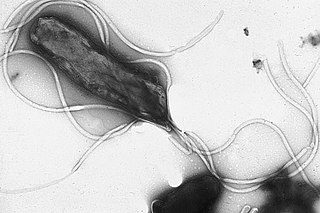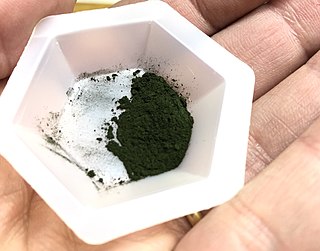Related Research Articles

Campylobacter is a type of bacteria that can cause a diarrhea disease in people. Its name means "curved bacteria", as the germ typically appears in a comma or "s" shape. According to its scientific classification, it is a genus of gram-negative bacteria that is motile.

Helicobacter pylori, previously known as the name Campylobacter pyloris, is a gram-negative, flagellated, helical bacterium. Mutants can have a rod or curved rod shape, and these are less effective. Its helical body is thought to have evolved in order to penetrate the mucous lining of the stomach, helped by its flagella, and thereby establish infection. The bacterium was first identified as the causal agent of gastric ulcers in 1983 by the Australian doctors Barry Marshall and Robin Warren.

Helicobacter is a genus of gram-negative bacteria possessing a characteristic helical shape. They were initially considered to be members of the genus Campylobacter, but in 1989, Goodwin et al. published sufficient reasons to justify the new genus name Helicobacter. The genus Helicobacter contains about 35 species.

Campylobacter jejuni is a species of pathogenic bacteria, one of the most common causes of food poisoning in Europe and in the US. The vast majority of cases occur as isolated events, not as part of recognized outbreaks. Active surveillance through the Foodborne Diseases Active Surveillance Network (FoodNet) indicates that about 20 cases are diagnosed each year for each 100,000 people in the US, while many more cases are undiagnosed or unreported; the CDC estimates a total of 1.5 million infections every year. The European Food Safety Authority reported 246,571 cases in 2018, and estimated approximately nine million cases of human campylobacteriosis per year in the European Union.

Campylobacteriosis is among the most common infections caused by a bacteria in humans, often as a foodborne illness. It is caused by the Campylobacter bacterium, most commonly C. jejuni. It produces an inflammatory, sometimes bloody, diarrhea or dysentery syndrome, and usually cramps, fever and pain.

A microaerophile is a microorganism that requires environments containing lower levels of dioxygen than that are present in the atmosphere (i.e. < 21% O2; typically 2–10% O2) for optimal growth. A more restrictive interpretation requires the microorganism to be obligate in this requirement. Many microaerophiles are also capnophiles, requiring an elevated concentration of carbon dioxide (e.g. 10% CO2 in the case of Campylobacter species).
The oxidase test is used to determine whether an organism possesses the cytochrome c oxidase enzyme. The test is used as an aid for the differentiation of Neisseria, Moraxella, Campylobacter and Pasteurella species. It is also used to differentiate pseudomonads from related species.

Campylobacterota are a phylum of bacteria. All species of this phylum are Gram-negative.

This is a timeline of the events relating to the discovery that peptic ulcer disease and some cancers are caused by H. pylori. In 2005, Barry Marshall and Robin Warren were awarded the Nobel Prize in Physiology or Medicine for their discovery that peptic ulcer disease (PUD) was primarily caused by Helicobacter pylori, a bacterium with affinity for acidic environments, such as the stomach. As a result, PUD that is associated with H. pylori is currently treated with antibiotics used to eradicate the infection. For decades prior to their discovery, it was widely believed that PUD was caused by excess acid in the stomach. During this time, acid control was the primary method of treatment for PUD, to only partial success. Among other effects, it is now known that acid suppression alters the stomach milieu to make it less amenable to H. pylori infection.

Helicobacter cinaedi is a bacterium in the family Helicobacteraceae, Campylobacterales order, Helicobacteraceae family, Helicobacter genus. It was formerly known as Campylobacter cinaedi until molecular analysis published in 1991 led to a major revision of the genus Campylobacter. H. cinaedi is a curved, spiral, or fusiform rod with flagellum at both of its ends which it uses to dart around. The bacterium is a pathogen.

Cresyl violet is an organic compound with the chemical formula C19H18ClN3O. It is a basic dye and is used as a common stain in histology.

Viable but nonculturable (VBNC) bacteria refers as to bacteria that are in a state of very low metabolic activity and do not divide, but are alive and have the ability to become culturable once resuscitated.
Arcobacter is a genus of Gram-negative, spiral-shaped bacteria in the phylum Campylobacterota. It shows an unusually wide range of habitats, and some species can be human and animal pathogens. Species of the genus Arcobacter are found in both animal and environmental sources, making it unique among the Campylobacterota. This genus currently consists of five species: A. butzleri, A. cryaerophilus, A. skirrowii, A. nitrofigilis, and A. sulfidicus, although several other potential novel species have recently been described from varying environments. Three of these five known species are pathogenic. Members of this genus were first isolated in 1977 from aborted bovine fetuses. They are aerotolerant, Campylobacter-like organisms, previously classified as Campylobacter. The genus Arcobacter, in fact, was created as recently as 1992. Although they are similar to this other genus, Arcobacter species can grow at lower temperatures than Campylobacter, as well as in the air, which Campylobacter cannot.
Ruminococcus is a genus of bacteria in the class Clostridia. They are anaerobic, Gram-positive gut microbes. One or more species in this genus are found in significant numbers in the human gut microbiota. The type species is R. flavefaciens. As usual, bacteria taxonomy is in flux, with Clostridia being paraphyletic, and some erroneous members of Ruminococcus being reassigned to a new genus Blautia on the basis of 16S rRNA gene sequences.
Campylobacter concisus is a Gram-negative, highly fastidious, mesophilic bacterium that grows under both anaerobic and microaerobic conditions with the presence of hydrogen significantly aiding growth. Motile, with either unipolar or bipolar flagella, the organisms have a characteristic spiral/corkscrew appearance and are oxidase-positive. Although the human oral cavity is the natural colonization site of the bacterium, C. concisus may also colonize the intestinal tract of some individuals. In particular, several studies have reported higher intestinal prevalence of C. concisus in patients with IBD compared to healthy controls, which has led to current speculation of the bacterium's implication in the induction of Crohn's disease.

Fumarate reductase (quinol) (EC 1.3.5.4, QFR,FRD, menaquinol-fumarate oxidoreductase, quinol:fumarate reductase) is an enzyme with systematic name succinate:quinone oxidoreductase. This enzyme catalyzes the following chemical reaction:
Helicobacter muridarum is a bacterium in the Helicobacteraceae family, Campylobacterales order. It is microaerophilic and helical and was first isolated from the intestinal mucosa of rodents, hence its name. It is characterised by the presence of 9 to 11 periplasmic fibers which appear as concentric helical ridges on the surface of each cell. The cells are motile and have bipolar tufts of 10 to 14 sheathed flagella. These bacteria are nutritionally fastidious and physiologically similar to other Helicobacter species and Wolinella succinogenes, but can be differentiated from these organisms by their unique cellular ultrastructure. ST1T is its type strain.
Interspecies hydrogen transfer (IHT) is a form of interspecies electron transfer. It is a syntrophic process by which H2 is transferred from one organism to another, particularly in the rumen and other anaerobic environments.
Methanogens are a group of microorganisms that produce methane as a byproduct of their metabolism. They play an important role in the digestive system of ruminants. The digestive tract of ruminants contains four major parts: rumen, reticulum, omasum and abomasum. The food with saliva first passes to the rumen for breaking into smaller particles and then moves to the reticulum, where the food is broken into further smaller particles. Any indigestible particles are sent back to the rumen for rechewing. The majority of anaerobic microbes assisting the cellulose breakdown occupy the rumen and initiate the fermentation process. The animal absorbs the fatty acids, vitamins and nutrient content on passing the partially digested food from the rumen to the omasum. This decreases the pH level and initiates the release of enzymes for further breakdown of the food which later passes to the abomasum to absorb remaining nutrients before excretion. This process takes about 9–12 hours.
References
- ↑ Parte, A. C. "Wolinella". LPSN .
- ↑ taxonomy. "Taxonomy browser (Wolinella succinogenes DSM 1740)". www.ncbi.nlm.nih.gov. Retrieved 2016-04-03.
- ↑ Nutrition, Center for Food Safety and Applied. "Bad Bug Book - BBB - Campylobacter jejuni". www.fda.gov. Retrieved 2016-04-03.
- ↑ "Helicobacter Pylori Infections: MedlinePlus". www.nlm.nih.gov. Retrieved 2016-04-03.
- ↑ "Details: DSM-1740". www.dsmz.de. Retrieved 2016-04-03.
- ↑ Wolin, M. J.; Wolin, E. A.; Jacobs, N. J. (1961-06-01). "Cytochrome-producing anaerobic Vibrio succinogenes, sp. n". Journal of Bacteriology. 81: 911–917. ISSN 0021-9193. PMC 314759 . PMID 13786398.
- ↑ GBIF. "Wolinella Tanner et al., 1981 - Checklist View". www.gbif.org. Retrieved 2016-04-16.
- ↑ taxonomy. "Taxonomy browser (Wolinella)". www.ncbi.nlm.nih.gov. Retrieved 2016-04-05.
- ↑ García-Amado, M. Alexandra; Al-Soud, Waleed Abu; Borges-Landaéz, Pedro; Contreras, Monica; Cedeño, Samandhy; Baéz-Ramírez, Estalina; Domínguez-Bello, M. Gloria; Wadström, Torkel; Gueneau, Pulchérie (2007-10-01). "Non-pylori Helicobacteraceae in the upper digestive tract of asymptomatic Venezuelan subjects: detection of Helicobacter cetorum-like and Candidatus Wolinella africanus-like DNA". Helicobacter. 12 (5): 553–558. doi:10.1111/j.1523-5378.2007.00526.x. ISSN 1083-4389. PMID 17760725.
- ↑ Iannotti, E. L.; Kafkewitz, D.; Wolin, M. J.; Bryant, M. P. (1973-06-01). "Glucose fermentation products in Ruminococcus albus grown in continuous culture with Vibrio succinogenes: changes caused by interspecies transfer of H 2". Journal of Bacteriology. 114 (3): 1231–1240. ISSN 0021-9193. PMC 285387 . PMID 4351387.
- ↑ Greening, Chris; Geier, Renae; Wang, Cecilia; Woods, Laura C.; Morales, Sergio E.; McDonald, Michael J.; Rushton-Green, Rowena; Morgan, Xochitl C.; Koike, Satoshi; Leahy, Sinead C.; Kelly, William J. (October 2019). "Diverse hydrogen production and consumption pathways influence methane production in ruminants". The ISME Journal. 13 (10): 2617–2632. doi:10.1038/s41396-019-0464-2. ISSN 1751-7370. PMC 6776011 . PMID 31243332.